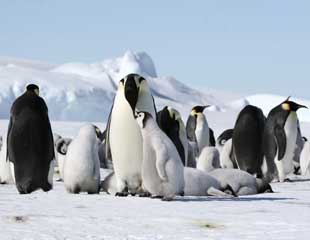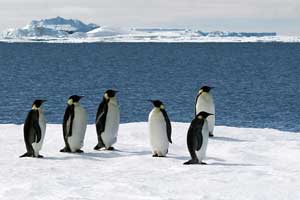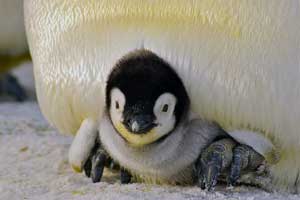Penguin Facts
Posted by Admin / in Science Facts

These Emperor Penguin chicks still have their down.
Learn about penguins by reading our penguin facts. Penguins can survive in places that most animals cannot. A majority of penguins live where the weather reaches extremely cold conditions. Since these are areas, where most humans avoid, millions of penguins live their entire lives without any human interaction. Most of us see penguins in a zoo or at an aquarium. When penguins are around people they are playful. This is why many people love penguins!
Penguin Facts
- Penguins are birds, not mammals. They have feathers and are hatched from eggs.
- Even though there are many penguins now in zoos and aquariums, all penguins came from the Southern Hemisphere. In fact, a majority of penguins live in an extremely cold climate on Antarctica and the islands surrounding Antarctica.
Penguin Facts: Penguin Species
There are 17 species of penguins found in the world. All 17 species are found in nature only in the Southern Hemisphere. Here is a list of all 17 of the penguin species and where they are found.
- Emperor Penguin – Antarctica
- King Penguin – Islands surrounding Antarctica (Falkland Islands, South Georgia, Prince Edward/Marion, Kerguelen and Macquarie)
- Gentoo Penguin – Antarctica and the Islands surround Antarctica (Heard, Kerguelen, South Sandwich, South Georgia, Falkland Islands and Macquarie)
- Chinstrap Penguin – Antarctica and the Islands surrounding Antarctica (South Sandwich, South Georgia, Amsterdam, and Kerguelen)
- Adélie Penguin – Antarctica and South Sandwich
- Yellow-eyed Penguin – New Zealand and Enderly
- Royal Penguin – Macquarie
- Macaroni Penguin – Heard, Kerguelen, Crozet, South Sandwich, South Georgia, Falkland Islands and the Southern tip of South America
- Rockhopper Penguin – Macquirie, Antipodes & Bounty, Enderly, Heard, Kerguelen, Crozet, Prince Edward/Marion, Amsterdam, Falkland Islands and the Southern tip of South America
- Fiordland Penguin – Snares (near New Zealand)
- Erect-Crested Penguin – Antipodes & Bounty
- Snares Penguin – Snares and new Zealand
- Magellanic Penguin – South America and Falkland Islands
- Humboldt Penguin – South America
- African Penguin – South Africa
- Galápagos Penguin – Galápagos Islands
- Little Penguin – New Zealand and Australia
- Big Divers – Emperor and King Penguins
- Brush-Tailed – Genatoo, Chinstrap and Adélie Penguins
- Yellow-Eyed – Yellow-Eyed Penguins
- Crested Penguins – Royal, Macaroni, Rockhopper, Fiordland, Erect-crested and Snares Penguins
- Banded – Magellanic, Humboldt, African and Galápagos Penguins
- Good Little Diver – Little Penguin
- Penguins have feathers, but they are not used to help them fly. Instead a penguins feathers help them stay warm in the cold water and on land when it is cold. Penguins have a special oil that helps them waterproof their feathers. The waterproofing helps penguins to stay warm and dry in the water or on land. Feathers cover a penguin's entire body, even their head and face. The only parts of a penguin not covered by feathers are their feet and beak.
- Baby penguins are hatched with down, not feathers. Penguin chicks cannot swim until they grow their feathers. The time it takes for a penguin to grow feathers that are waterproof varies, depending on the species of penguin. Typically it takes between 5 to 10 months.

Emperor Penguins live in the Artarctica like these penguins on an ice sheet.
Penguin Facts: Penguin Genera
Penguins are organized into 6 groups (genera) based on their size, appearance and behavior.
Penguin Facts: What Penguins Eat
Penguins are all predators who eat other animals. There are no trees and very little vegetation where most penguins live, so they must survive by eating other animals. Penguins eat fish, krill and squid. Most penguins dive under the water for their food. The Emperor Penguin is known to dive the deepest of all the penguins, over 550 meters (1800 feet).
Penguin Facts: Penguin Feathers

This penguin chick does not yet have waterproof feathers and is not ready to swim.
